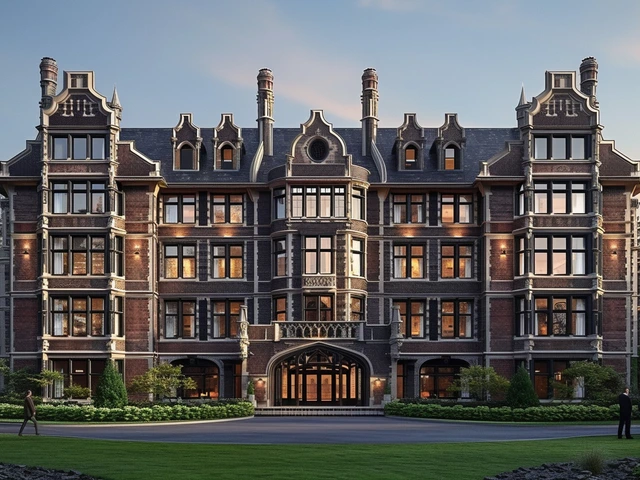Embracing the Past: Historical Context of Greek Revival Architecture
Picture this: it’s a sunny afternoon in ancient Athens. The marbled steps beneath you are warm to the touch, and above you, the Parthenon stands tall, a testimony to the engineering prowess and high aesthetic standards of its creators. Those magnificent columns, those exquisite capitals, they stand as physical manifestations of a civilization, its beliefs, its achievements and its history. Now fast forward a few thousand years and continents apart - Greek Revival Architecture finds its roots deeply embedded in this glorious past.
Around the 18-19th Century, the world looked towards ancient Greece as the fountainhead of cultures. The vibrant tales of heroism, the rich pantheon of Gods, the democratic tradition, they all fuelled a fascination that transformed into a stylistic preference, termed as the Greek Revival Architecture. This was more than just about buildings, it represented an ideological shift, an aspiration to recreate the spirit of democracy, and virtues of simplicity, balance, and restrained grandeur of the ancient Greek architecture.
A Grecian Odyssey: The Birth and Spread of Greek Revival Architecture
The Greek Revival style, fondly christened as the 'National Style' in the United States, is an ethereal product of centuries of architectural progression. Its roots trace back to ancient Greece, but the bud blossomed sometime in the 18th century when Europe entered the neoclassical period. This was around the time archaeologists were brushing the dust off hitherto unknown Greek cities and colonies, thus fueling widespread interest.
Soon, the architectural idiom slip-streamed across the Atlantic to the United States, following the War of Independence. The young nation, in search of a distinctive national architecture that echoed the principles of Greek democracy, found the ideal in the Greek Revival. From public buildings to humble homes, the unpretentious form and balanced proportions of the style gained popularity, ultimately leading to the birth of Greek-revival towns mirroring the glory of by-gone Athens.
Echoes of the Past: Greek Revival Architectural Features
The Greek Revival style's intrinsic allure draws from its simple, elegant architectural grammar. The style predominantly showcases Grecian elements and concepts, starting with thick but tapering 'Doric' style pillars crowning into exquisite capitals. The column for instance, wasn't just an architectural necessity to support the roof but a symbol of aesthetic structural logic, a nod to the rich influence of Greek thought.
Among other compelling features include the triangular gables or 'pediments', an iconic element used in Greek temples. Strong symmetry and rectilinear forms also mark this style, emphasizing balance and aesthetic harmony. Certain architectural elements associated with the Greek Revivial, like the Porch, still persist in modern day homes as an elegant addition to the façade.
Wooden Temples: Greek Revival in Residential Architecture
I must mention, while pontificating about Greek Revival, the aspect of residential architecture is in no way to be undercut. While public structures were mired deep in this architectural fashion, taste buds of homeowners were equally seduced by these columned marvels of the past. Intriguingly, many homeowners could recreate the ancient Greek vibe through simple wooden renditions.
So while the minimalistic edifice garnered ample praise, it was quite comical how straightforward it was to build a Greek Revival home. One of the times… I remember around a decade ago, eh, wait! I just gave away my age, didn’t I? Never mind! I was working on a book on architectural styles, and this very enthusiastic couple flaunted their fabulous DIY Greek Revival pergola. Pardon the long tangent, but just to give you an idea of how accessible and flexible the style can be!
Forever Greek: Significance and Survival of Greek Revival Architecture
The endurance of the Greek Revival movement epitomizes the transcendent nature of architecture. It happens to stand resilient across time, continents, and various socio-political climates. The fact that the White House, the home of US democracy, sports this style is a manifestation of that fact.
From 21st century townhomes to iconic courthouses, the Greek Revival continues to have a significant architectural presence and influence. The glamour attached to the marble-clad temples of Athens may have waned, but Greek Revival is alive in the DNA of modern western architectural traditions, blending harmoniously with postmodern ideologies and aesthetics.
Revival of the Revival: Contemporary Relevance of Greek Revival Architecture
Now comes the 24-karat question – how does Greek Revival fare in the 21st Century? The answer is – it’s a live wire! Greek Revival Architecture has its roots seeping into contemporary architecture, imbuing it with influences that are unmistakable. The statuesque features of Greek architectural grammar, stripped down and re-shaped, frame our modern built environment.
I recall a recent home tour I attended where, much to my delight, the homeowner had seamlessly merged Greek Revival with mid-century modern minimalism. It was like walking into an architectural twilight zone, a fine blend of the antiquarian charm with the sleek lines of modern design. A scene like this is not uncommon today, as more people search for ways to incorporate historical aesthetics into their modern homes.
Seeing Greek in the Everyday: Tips to Spot Greek Revival Elements
To the untrained eye, the nuances of architectural styles might be difficult to discern. Fear not, good folks! I present to you some key tips to identify Greek Revival architecture around you. First, look for those famed pillars - they are generally the most visible feature. Taken from the three orders of Greek columns, Doric, Ionic and Corinthian, they are a dead giveaway.
Next, turn your attention to the roof. Greek Revival structures typically have a gabled or hipped roof with a wide trim or frieze under the eaves. Lastly, the entrance will usually be an elaborate porch or portico, an open symmetrical space enclosed by columns. Remember, Greek Revival is all about balance, symmetry, and precision – all encapsulated in a noble simplicity that characterizes the style.
A Sojourn in Style: Greek Revival in Melbourne
For those of you exploring Greek Revival wonders in my hometown of Melbourne, you're in for a treat. Although Melbourne is better known for its Victorian and Gothic Revival architecture, there are still a few dazzling expressions of Greek Revival tucked away in corners.
An honorable mention definitely goes to St Kilda's pavilion at the end of Kerford Road Pier, a green-tiled beauty supported by towering Doric columns. This dainty building has its fair share of history too! Established in 1904, it saw massive damages during WWII, only to be revived later, hence embodying the literal spirit of 'revival'. Its enduring presence on the city's coastline is a testament to the timelessness of Greek Revival Architecture.





Leave a Comments